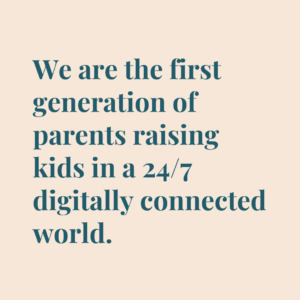One of the top concerns raised by parents at my clinic is the amount of time children spend on electronic devices, and how to manage this issue without constant fights, arguments, and distress for everyone involved.
The number of devices and types of digital media has exploded over the past 20 years and continues to grow. Parents and professionals have many questions and concerns about the impact these devices have on children, and the best ways to manage them to keep kids safe and healthy.
While electronic devices and digital media have certainly improved our lives in many ways, research has shown that many problems can result from overexposure. As both a clinician and a parent, I see firsthand the numerous mental and physical health issues that can happen to children, teens, and young adults when they spend too much time in front of screens, and too little time engaged with the people and activities around them. There are many areas of health and function that can be negatively impacted, and parents need to be aware of these problems in order to set expectations and boundaries that help kids develop healthy device habits.
How do Electronic Devices Affect Our Health?
Overexposure to electronic devices can have a huge impact on many areas of our kids’ health, and can cause a wide variety of related issues:
- Sleep deprivation
- Low energy
- ADHD
- Anxiety
- Depression
- Increased stress
- Addiction
- Aggression and impulsivity
- Obesity
- Type 2 diabetes
- Developmental issues (especially in young kids)
- Dry-eye disease
- Decreased hand-eye coordination
- Reduced ability to form social connections and relationships
- Reduced executive function
- EMF overexposure
This is quite a large list of potential problems with electronics! Let’s take a look at these issues with more detail to gain a better understanding of the risks we take when we let our kids use electronics for long periods of time.
Sleep Issues
Many people aren’t aware of the direct connection between electronic device use and sleep problems. Overuse of devices, particularly close to bedtime, can negatively impact sleep for children and adults. Use of electronic devices makes it harder to fall asleep, disrupts sleep during the night, and causes poorer quality sleep in general.1 These devices emit a type of blue light that tricks the brain into thinking it is daytime. Using devices near bedtime increases the likelihood of problems falling asleep. This is especially problematic for children because they need more sleep than adults. Loss of even a half hour of sleep can negatively impact their behavior the next day.
The use of electronic devices can also create difficulties with staying asleep. Notifications, ringtones, and other sounds coming from devices during the night can wake children and disrupt their sleep.2 If the child wakes to answer a text or look at the Instagram post, it not only reduces the amount of sleep they are getting but makes it harder for them to go back to sleep. It is not unusual for my teenage patients to report that they are awakened multiple times each night to respond to notifications on their smartphones. Then they struggle to fall back to sleep because they are thinking about whatever happened via text or on social media. These nighttime interruptions can have highly negative effects on the child’s mood, behavior, focus, and all other aspects of behavior the next day. Sleep disrupted like this over time can cause severe sleep deprivation that can result in serious physical and mental health problems.
Mental Health Problems (Why Electronics are Bad for the Brain)
Most parents would agree that the more time our kids spend in front of screens, the grumpier they get! As a parent, I can absolutely say that this happens to my four kids; and parents at my clinic note this for their children as well. Kids can quickly become overstimulated from screen time without realizing it, which leads to worse moods, more anxiety, higher levels of irritability, and poor behavior.
Many research studies have explored the connections between children’s use of electronic devices and mental health, and the results are clear: As use increases, so does the risk of mental health problems including depression, anxiety, ADHD, mood disorders, and suicidality. Teens who use electronic devices for more than two hours per day report significantly more mental health symptoms, increased psychological distress, and more suicidal ideation.3 Children using devices for more than 2 hours per day have increased risk of depression, and that risk rises as screen time increases. The lowest risk is observed in children who use devices for less than 1 hour daily.4 Studies have shown that children with ADHD symptoms spend more hours engaged in screen time activities than children without ADHD.5 As the amount of time spent with devices increases, so do symptoms of ADHD. There is clearly a connection!
Kids frequently attempt to reach out for support or validation on social media in the form of likes, clicks, or comments. When they do not get the feedback they are looking for, however, stress levels increase and the risk of depression rises.6 Fear of missing out on what others are saying and doing online also drives up stress and anxiety levels.7,8 Many feel a need to be constantly responsive to messages on social media, texts, and chats, which increases anxiety and also interrupts sleep-which further worsens anxiety symptoms.9
The content children are exposed to online can also lead to mental health problems.10 Many parents are not aware of the vast amount of online content that glorifies and perpetuates serious mental health problems such as promoting eating disorders, and sites dedicated to demonstrating self-harm and drug use. There are also sites about body image that can have very negative impact on the self-esteem and body perceptions of girls in particular.11 Excessive time spent on Internet games can lead to depression, aggression, impulsivity, substance use, and physical brain changes.12, 13
Pornographic content is rampant online, and children are exposed to much more than adults realize. In the US, 73% of young people in the US (93% of boys and 62% of girls) report that they have been exposed to online pornography before the age of 18.14 Exposure to this type of content can lead to significant negative consequences if parents are not aware and the issue is not discussed and addressed for the child.
People casually use the term “Internet addiction” or “phone addiction” to describe the obsessive use of devices. Unfortunately, this is a very real phenomenon that has developed in the past decade, with even young children demonstrating symptoms of addiction.15 Centers now exist all over the country to address serious digital media addiction problems for children, teens, and young adults, as some children become so enmeshed in this behavior that inpatient specialty treatment is necessary to provide detox and rehabilitation supports. All parents should be motivated to address these issues with their children before this level of intervention is required!
Physical Health Issues (Why Electronics are Bad for the Body)
Research has shown that increased time with electronic devices can lead to a wide variety of serious health problems including insulin resistance, obesity, increase abdominal fat, and higher risk of Type 2 Diabetes.16, 17 There seem to be several reasons for the increase in these physical health problems when screen time increases: Kids are more sedentary and move less, they tend to eat more, and they make poorer food choices. The more time children spend watching TV, movies, and engaging with online media, the more they are exposed to food and restaurant advertisements aimed at children. This impacts their preference for certain foods, the vast majority of which are not healthy and promote obesity, high blood sugar, and other physical health concerns.18 Children and adults also tend to eat more mindlessly when engaged in screen time, which can lead to overeating.
There is also the obvious issue that screen time is primarily sedentary in nature, meaning that children are sitting or lying around while using devices. Most children in the US spend the majority of their time sitting, both inside and outside of school. More time spent sitting leads to weight gain, poor muscle development, and many other physical problems. Lack of physical movement also negatively impacts brain development, as it is needed to form brain connections necessary for everything from physical coordination to communication to social skills. Kids who don’t move enough risk developmental and learning problems, motor skills challenges, mental health problems, and more.19 Movement supports all aspects of physical and brain health, and kids aren’t getting enough of it when they are spending hours each day sitting in front of devices.
Vision Issues
The more time kids spend looking at screens, the higher the chance of developing various types of eye and vision-related problems. Dry-eye disease has become a more common issue eye doctors screen for in children during eye exams, as frequent viewing of screens changes our rate of blinking. This can lead to chronic dry eyes and difficulty tolerating contact lenses.20 Computer Vision Syndrome is the term for the negative impact that frequent electronic device use can have on our eyes and visual function. The strain of constantly using near-point vision on electronic devices is especially problematic for children, many of whom are becoming nearsighted as a result. Children may also develop problems shifting their vision from near to far, and integrating their vision and motor skills.21 This has the potential to make handwriting, cutting, sports activities, and any other skill involving the coordination of vision and motor skills more difficult. These kinds of vision problems also make it much more difficult for children to function in school classrooms.
Poor Relationships, Communication Problems, and Social Disconnection
Technology has the potential to bring people together and encourage relationships; and there can certainly be social benefits for children using digital media, including social media. Children and teens with social anxiety disorders and other issues can practice with social interaction and gain social support in a less intimidating way.22 Many support groups and other types of online communities are available where kids can benefit from sharing their experiences, and receive support from others in similar situations.
However, research shows that increased technology use has the potential to create social disconnection, and negatively impact the development of social and relational skills. Kids who are exposed to violent video games, TV shows, and movies tend to have more aggressive behaviors, poorer perspective-taking abilities, and reduced moral development.23, 24 Technology use can also negatively impact children’s understanding of how to engage with others. Research showed that just one week of engagement in typical overnight camp activities, with no screen time, led to a significant improvement in children’s ability to read non-verbal emotional cues.25 Non-verbal cues are a critical component of social communication, and deficits in this area create difficulties for children in forming relationships and communicating effectively with others.
Excessive screen time also leads to a reduction in quality family time, and an increase in serious parent-child conflicts can result from frequent use of cell phones and social media.26 Too much time spent on digital media consumption, including Internet use, takes away from time spent socializing with friends, working on learning activities, and engaging with the world around them.27 This reduction in the amount of time spent engaging in face-to-face interactions with adults and peers can result in poorer social skills, increased social anxiety, and lower quality relationships overall.
Cyberbullying is another significant social issue, as the anonymity of online interaction can lead children to utilize less self-control and behave in ways they would not offline.28 Many children and teens report being bullied in some way online. Parents are often unaware that their children are victims of cyberbullying, and this is unfortunate as cyberbullying leads to significant long-lasting negative effects such as anxiety, depression, increased stress, and suicidality.29 Protective factors against cyberbullying include consistent parent monitoring of Internet use, and boundaries on time spent on the Internet and content consumed.30 Here’s another article I published that goes into more detail about electronics and the effect on communication.
Cognitive Skills Development
Some people argue that playing video games and engaging with online activities encourages the development of various types of cognitive skills. It is true that kids may get benefits from certain video games in the areas of improved visual attention, processing speed, and mental rotation. However, research also shows that important higher-level cognitive skills such as critical thinking, reflection, and imagination may get weaker as a result of these same types of video games and online activities.31 Executive functions of the brain, including sustained attention, working memory, and ability to inhibit impulses, develop throughout childhood and adolescence. The development of these executive functions can be impaired by overexposure to digital media, particularly shows and games that are very fast-paced and focused on fantasy rather than reality.32
Of particular concern is the impact of digital media on children’s ability to control their attention and delay gratification. Children who spend time flipping from one game or online activity to the next develop a higher threshold for stimulation and tend to become more easily bored with tasks that are not fast-paced and constantly shifting from one type of stimulation to the next. These children also tend to be more focused on immediate gratification and struggle to make decisions based on anything beyond what is immediately in front of them.33 This leads to lower frustration tolerance, and the tendency to give up on tasks and situations without persevering or problem solving before just moving on to the next thing.
We know that exposure to digital media below 2 years of age negatively impacts language and cognitive development.34 Even background exposure to TV has negative effects on child development, as it competes for attention with playing with toys and interacting with others.35 Too much time spent watching TV and playing video games, including online games, is associated with greater levels of attention problems;36 and playing these games for over an hour each day sets kids up for more issues with focus and attention.37 Young adult students report that they are less focused and behave in more impulsive and hyperactive ways as their use of electronic devices increases.38
Academic Problems and Learning Challenges – The Negative Effects of Electronics for Students
Increased time on electronic devices is also associated with poorer academic outcomes.39 The more time children spend consuming digital media, the less time they tend to spend reading.40 This has negative effects on learning as students progress through school. While many schools are moving to computerized instruction and tablet-based learning, the reality is that there is no strong research evidence to support that this is beneficial for students.41 It is problematic that students are now spending a significant amount of time in front of screens during the school day, which increases the overall amount of screen-time exposure each day and week–and there is no real evidence that this is helpful or supportive for learning!
One of the specific learning issues relates to increased computer/keyboard use. Children benefit from handwriting more than typing, especially at young ages, as handwriting helps them develop reading skills.42 Handwriting also involves fine motor skills, which are beneficial for improving reading and writing in children.43 The more time kids spend typing or using touch screens, the less time they are spending on small motor skills such as forming letters and coloring with crayons or pencils. This has a negative impact on their brain development and academic functioning.
EMF Exposure
One growing area of concern is the research evidence showing that human brains may be harmed by overexposure to the actual electronic devices themselves and that children are especially susceptible.44 The electromagnetic fields (EMFs) created by these devices can impact health both physically and mentally and may cause problems for memory, learning, behavior, attention, and physical brain development. While EMF exposure in smaller doses doesn’t appear to be a concern over short periods of time, the more frequent and intense the exposure the more problems that can result. This is especially true for children, as their brains are rapidly growing and changing from birth through adolescence.
Holding devices close to the head during a phone conversation, for example, exposes the brain to more artificial EMFs than having the phone on the table and using speakerphone. Children who use devices close to their faces/heads for lengthy periods of time throughout the day are potentially more at risk for the damaging effects of EMF exposure than those who use these devices less often and for briefer periods of time. The reality is that we don’t yet understand the full impact of exposure to these devices, as they are continually evolving and too new to have long-term research.45 Parents would be wise to understand the potential for physical and neurological problems, and this is yet another reason to monitor and enforce limits for children around device usage.
If you weren’t already convinced that overuse of electronic devices can cause problems for kids, I hope this information has improved your awareness of the issue. Most parents I see in my clinic don’t understand the direct connection between electronics use and their child’s mood, attention, anxiety, hyperactivity, and behavior issues. There are many simple strategies and expectations parents can implement to reduce these problems, including:
- Reduce electronics use before bedtime
- Avoid electronics in kids’ bedrooms
- Spend less time overall on devices
- Take movement breaks periodically to avoid sitting for too long
- Monitor your child’s Internet use and social media accounts
- Look at the content and digital books together with young children
- Make sure time is spent on developmentally appropriate activities such as coloring, playing with toys, socializing with friends, doing outdoor activities, etc.
- Avoid holding devices close to the head for long periods of time
- Make sure that kids have other interests and activities beyond screen time
To help you address these issues, I’ve created a comprehensive guide that shows you exactly what to do to help your children (birth through young adults) use electronic devices in healthy ways–without feeling like you might lose your mind in the process!
It covers how to set and enforce expectations around device use, avoid arguments and conflicts with your kids about electronics, keep your children safe, and ensure better mental and physical health for them now and into the future.
What You Should Do Next:
Sign up for my Better Behavior Naturally community newsletter
Sign up for my newsletter to get tips, resources, and supports to improve your child’s attention, anxiety, mood, and behavior…while making your job as a parent easier.
Enroll in one of my workshops
Check out one of my many workshops where you’ll join my exclusive community of parents in a one-of-a-kind virtual resource accessible 24/7. Whether you’ve got a child with a diagnosis like autism or ADHD, or are becoming more and more frustrated with a child who struggles to listen and cope, these workshops are designed to give you the information, tools, and support you need…whenever you need it.
References:
- Lemola, S., Perkinson-Gloor, N., Brand, S., Dewald-Kaufmann, J. & Grob, A. (2015). Adolescents’ electronic media use at night, sleep disturbance, and depressive symptoms in the smartphone age. Journal of Youth and Adolescence, 44(2), 405-418. doi: 10.1007/s10964-014-0176-x
- Cain, N. & Gradisar, M. (2010). Electronic media use and sleep in school-aged children and adolescents: a review. Sleep Medicine, 11(8), 735-742.
- Sampasa-Kanyinga, H. & Lewis, R.F. (2015). Frequent use of social networking sites is associated with poor psychological functioning among children and adolescents. Cyberpsychology, Behavior, and Social Networking, 18(7), 380-385. doi: 10.1089/cyber.2015.0055
- Liu, M., Wu, L., & Yao, S. (2015). Dose-response association of screen time –based sedentary behaviour in children and adolescents and depression: a meta-analysis of observational studies. British Journal of Sports Medicine, 50(20). Retrived from: http://bjsm.bmj.com/content/early/2015/11/08/bjsports-2015-095084.long.
- Holton, K.F. & Nigg, J.T. (2016). The association of lifestyle factors and ADHD in children. Journal of Attention Disorders. Retrieved from: https://www.researchgate.net/profile/Kathleen_Holton/publication/301720055_The_Association_of_Lifestyle_Factors_and_ADHD_in_Children/links/573f275908aea45ee844f741/The-Association-of-Lifestyle-Factors-and-ADHD-in-Children.pdf
- Frison, E. & Eggermont, S. (2015). The impact of daily stress on adolescents’ depressed mood: the role of social support seeking through Facebook. Computers in Human Behavior, 44, 315-325. doi: 1016/j.chb.2014.11.070
- Beyens, I., Frison, E., & Eggermont, S. (2016). “I don’t want to miss a thing”: adolescents’ fear of missing out and its relationship to adolescents’ social needs, Facebook use, and Facebook related stress. Computers in Human Behavior, 64, 108. doi: 1016/j.chb.2016.05.083
- Morin-Major, J.K., Marin, M.F., Durand, N., Wan, N., Juster, R.P., & Lupien, S.J. (2016). Facebook behaviors associated with diurnal cortisol in adolescents: is befriending stressful? Psychoneuroendocrinology, 63, 238-246. doi: 1016/j.psyneuen.2015.10.005
- Woods, H. & Scott, H. (2015). #Sleepyteens – Social media use in adolescence is associated with poor sleep quality, anxiety, depression and low self-esteem. Journal of Adolescence, 51, 41-49. doi: 1016/j.adolescence.2016.05.008
- Livingstone, S., Haddon, L., Gorzig, A., & Olafsson, K. (2011). Risks and safety on the internet: The perspective of European children. LSE, London: EU Kids Online. Retrieved from http://www.lse.ac.uk/media%40lse/research/EUKidsOnline/EU%20Kids%20II%20(2009-11)/EUKidsOnlineIIReports/D4FullFindings.pdf
- Meier, E.P. & Gray, J. (2013). Facebook photo activity associated with body image disturbance in adolescent girls. Cyberpsychology, Behavior, and Social Networking, 17(4), 199-206. Retrieved from https://ai2-s2-pdfs.s3.amazonaws.com/2d88/556d63e0b7cd8c4b722a3bc765e496cdb055.pdf
- Liu, T.C., Desai, R.A., Krishnan-Sarin, S., Cavallo, D.A., & Potenza, M.N. (2011). Problematic internet use and health in adolescents: data from a high school survey in Connecticut. Journal of Clinical Psychiatry, 72(6), 836-845. doi: 10.4088/JCP.10m06057
- Wang, H., Jin, C., Yuan, K., Shakir, T.M., Mao, C., Niu, X., et al. (2015). The alteration of gray matter volume and cognitive control in adolescents with internet gaming disorder. Frontiers in Behavioral Neuroscience 9, 64. Retrieved from https://www.ncbi.nlm.nih.gov/pmc/articles/PMC4367166/
- Sabina, C., Wolak, J., & Finkelhor, D. (2008). The nature and dynamics of internet pornography exposure for youth. CyberPsychology & Behavior, 11(6), 691-693. Retrieved from http://www.unh.edu/ccrc/pdf/CV169.pdf
- Kuss, D.J. & Lopez-Fernandez, O. (2016). Internet addiction and problematic Internet use: A systematic review of clinical research. World Journal of Psychiatry, 6(1), 143-176. Retrieved from https://www.ncbi.nlm.nih.gov/pmc/articles/PMC4804263/.
- Nightingale, C.M., Rudnicka, A.R., Donin, A.S., Sattar, N., Cook, D.G., Whincup, P.H., & Owen, C.G. (2017). Screen time is associated with adiposity and insulin resistance in children. Archives of Disease in Childhood, 0:1-5. Retrieved from http://adc.bmj.com/content/archdischild/early/2017/02/06/archdischild-2016-312016.full.pdf
- Suchert, V., Hanewinkel, R., & Isensee, B. (2016). Screen time, weight status and the self-concept of physical attractiveness in adolescents. Journal of Adolescence, 48:11-17. Retrieved from https://www.researchgate.net/profile/Reiner_Hanewinkel/publication/293634188_Screen_time_weight_status_and_the_self-concept_of_physical_attractiveness_in_adolescents/links/56bc602508ae1d0da5fd2b09.pdf
- Strasburger, V.C., Jordan, A.B., & Donnerstein, E. (2010). Health effects of media on children and adolescents. American Academy of Pediatrics, 125, 756-767. doi: 10.1542/peds.2009-2563
- Eaton, W.O., McKeen, N.A., & Campbell, D.W. (2001). The waxing and waning of movement: Implication for psychological development. Developmental Review, 21, 205-223. Retrieved from http://home.cc.umanitoba.ca/~eaton/papers/Eaton_McKeen_Campbell_2001.pdf
- Schachter, S. (2017). How digital device usage is affecting youth. Optometry Times. Retreived from http://optometrytimes.modernmedicine.com/optometrytimes/news/how-digital-device-usage-affecting-kids
- Rosenfield, M. (2011). Coputer vision syndrome: a review of ocular causes and potential treatments. Opthalmic & Physiological Optics, 31(5), 502-515. Retrieved from http://onlinelibrary.wiley.com/doi/10.1111/j.1475-1313.2011.00834.x/full
- Ziv, I. & Kiasi, M. (2016). Facebook’s contribution to well-being among adolescent and young adults as a function of mental resilience. The Journal of Psychology, 150(4), 527-541. doi: 10.1080/00223980.2015.1110556
- Wilson, B.J. (2008). Media and children’s aggression, fear, and altruism. The Future of Children, 18(1), 87-118. Retrieved from: https://pdfs.semanticscholar.org/b83c/dc50b0006066d7dbfd4f8bc1aeecf81ddf1c.pdf
- You, S., Kim, E., & No, U. (2015). Impact of violent video games on the social behaviors of adolescents: the mediating role of emotional competence. School Psychology International, 36(1), 94-111. doi: 1177/0143034314562921
- Uhls, Y.T., Michikyan, M., Morris, J., Garcia, D., Small, G.W., Zgourou, E., & Greenfield, P.M. (2014). Five days at outdoor education camp without screens improves preteen skills with nonverbal emotion cues. Computers in Human Behavior, 39, 387-392. doi: 1016/j.chb.2014.05.036
- Subrahmanyam, K. & Greenfield, P. (2008). Online communication and adolescent relationships. The Future of Children, 18(1), 119-146. Retrieved from: http://files.eric.ed.gov/fulltext/EJ795861.pdf
- Livingstone, S., Haddon, L., Gorzig, A., & Olafsson, K. (2011). Risks and safety on the internet: The perspective of European children. LSE, London: EU Kids Online. Retrieved from http://www.lse.ac.uk/media%40lse/research/EUKidsOnline/EU%20Kids%20II%20(2009-11)/EUKidsOnlineIIReports/D4FullFindings.pdf
- Subrahmanyam, K. & Greenfield, P. (2008). Online communication and adolescent relationships. The Future of Children, 18(1), 119-146. Retrieved from: http://files.eric.ed.gov/fulltext/EJ795861.pdf
- Cassidy, W., Faucher, C., & Jackson, M. (2013). Cyberbullying among youth: a comprehensive review of current international research and its implications and application to policy and practice. School Psychology International, 34(6), 575-612. doi: 1177/0143034313479697.
- Khurana, A., Bleakley, A., Jordan, A.B., & Romer, D. (2015). The protective effects of parental monitoring and Internet restriction on adolescents’ risk of online harassment. Journal of Youth and Adolescence, 44(5), 1029-1047. doi: 10.1007/s10964-014-0242-4
- Greenfield, P.M. (2009). Technology and informal education: what is taught, what is learned. Science, 323(5910), 69-71. doi: 1126/science.1167190
- Lillard, A.S., Drell, M.B., Richey, E.M., Boguszeqski, K., & Smith, E.D. (2015). Further examination of the immediate impact of television on Children’s Executive Functioning. Developmental Psychology, 51(6), 792-805. Retrieved from http://faculty.virginia.edu/ASLillard/PDFs/Lillard%20et%20al.%20(2015).pdf
- Nikkelen, S.W.C., Valkenburg, P.M., Huizenga, M., & Bushman,, B.J. (2014). Media use and ADHD-related behaviors in children and adolescents: a meta-analysis. Developmental Psycyhology, 50(9), 2228-2241. Retrieved from http://pattivalkenburg.nl/images/artikelen_pdf/Nikkelen_Valkenburg_Huizinga_Bushman_2014_Media_use_and_ADHD_behavior_metaana.pdf
- Kirkorian, H.L., Wartella, E.A., & Anderson, D.R. (2008). Media and young children’s learning The Future of Children, 18(1), 39-61. Retrieved from http://www.futureofchildren.org/sites/futureofchildren/files/media/children_and_electronic_media_18_01_fulljournal.pdf
- Courage, M.L., Murphy, A.N., Goulding, S., & Setliff, A.E. (2010). When the television is on: the impact of infant-directed video on 6- and 18-month-old’s attention during toy play and on parent-infant interaction. Infant Behavior and Development, 33, 176-188. doi: 10.1016/j.infbeh.2009.12.012
- Swing, E.L., Gentile, D.A., Anderson, C.A., & Walsh, D.A. (2010). Television and video game exposure and the development of attention problems. American Academy of Pediatrics, 126(2), 214-221. doi: 1542/peds.2009-1508
- Chan, P.A. & Rabinowitz, T. (2006). A cross-sectional analysis of video games and attention deficit hyperactivity disorder symptoms in adolescents. Annals of General Psychiatry, 5, 16. Retrieved from https://www.ncbi.nlm.nih.gov/pmc/articles/PMC1635698/
- Ilaria, M., Guichard, E., & Kurth, T. (2016). Association of screen time with self-perceived attention problems and hyperactivity levels in French students: a cross-sectional study. BMJ Open, 6(2). Retrieved from http://bmjopen.bmj.com/content/6/2/e009089
- Trinh, L., Wong, B., & Faulkner, G.E. (2015). The independent and interactive associations of screen time and physical activity on mental health, school connectedness and academic achievement among a population-based sample of youth. Journal of the Canadian Academy of Child and Adolescent Psychiatry, 24(1):17-24. Retrieved from https://www.ncbi.nlm.nih.gov/pmc/articles/PMC4357330/
- Holton, K.F. & Nigg, J.T. (2016). The association of lifestyle factors and ADHD in children. Journal of Attention Disorders. Retrieved from: https://www.researchgate.net/profile/Kathleen_Holton/publication/301720055_The_Association_of_Lifestyle_Factors_and_ADHD_in_Children/links/573f275908aea45ee844f741/The-Association-of-Lifestyle-Factors-and-ADHD-in-Children.pdf
- Habler, B., Major, L., & Hennessy, S. (2016). Tablet use in schools: a critical review of the evidence for learning outcomes. Journal of Computer Assisted Learning, 32(2). 139-156. Retrieved from: https://larrycuban.files.wordpress.com/2015/08/hassler_major_hennessy_2015-_tablet_use_in_schools_a_critical_review_of_the_evidence_for_learning_outcomes-fc4.pdf
- James, K.H. & Engelhardt, L. (2012). The effects of handwriting experience on functional brain development in pre-literate children. Trends in Neuroscience and Education, 1(1), 32-42. Retrieved from: https://www.ncbi.nlm.nih.gov/pmc/articles/PMC4274624/
- Dinehart, L. & Manfra, L. (2013). Associations between low-income children’s fine motor skills in preschool and academic performance in second grade. Early Education and Development, 24(2), 138-161. doi: 1080/10409289.2011.636729
- Sage, C. & Burgio, E. (2017). Electromagnetic fields, pulsed radiofrequency radiation, and epigenetics: How wireless technologies may affect childhood development. Child Development. doi: 10.1111/cdev.12824
- Miah, T. & Kamat, D. (2017). Current understanding of the health effects of electromagnetic fields. Pediatric Annals, 46(4), e172-e174. Retrieved from: https://www.healio.com/pediatrics/journals/pedann/2017-4-46-4/%7B200c8f09-fd7e-40d5-b4e5-a893488c0387%7D/current-understanding-of-the-health-effects-of-electromagnetic-fields









